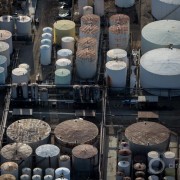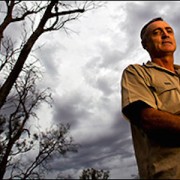Peter Gleick: When Beliefs Conflict with Facts
Representative Jim Costa and the California Drought
Last week, the Pacific Institute released a comprehensive assessment of the actual impacts of the 2007-2009 California drought. There is a lot of myth, misunderstanding, and misrepresentation swirling around about how the drought affected California agriculture, jobs, and the environment. Our report sets the record straight using real data, not political spin.
These data and facts apparently conflict with Representative Jim Costa’s political position or his basic beliefs (needless to say, this isn’t unique to Rep. Costa; many of his colleagues have the same problem with climate change science — a much longer discussion). After our report came out he posted a note to his constituents (the 20th Congressional District) on his House of Representatives webpage, entitled “The Pacific Institute is Wrong.”
As the famous physicist Richard Feynman said “If [your belief] disagrees with experience, it’s wrong. That’s all there is to it.” Congressman Costa’s beliefs about the links between the drought and the economic problems in his district, heartfelt though they may be, simply disagree with experience. Worse, his post makes it clear that he has not read the report or understood the data that it presents. Here are a few examples.
Representative Costa says: “The report claims that these [environmental] regulations had a minimal impact on our water supply because they accounted for only 25 percent of the problem.”
The Pacific Institute’s source on this matter was the Congressman’s own legislative research branch, the Congressional Research Service (CRS):
“Restrictions on water deliveries resulting directly from federal and state regulations, or imposed by courts’ interpretation of those rules, are estimated to range roughly from 20% to 25% of total water delivery reductions for 2009, depending on the time period used for estimating annual deliveries. The remaining 75%-80% of 2009 water reductions, according to the Department of the Interior, are due to “lack of run-off” (i.e., drought) and other factors. In the absence of the current three-year hydrological drought, it is unlikely that the existing regulatory water delivery restrictions would have created controversy of a similar magnitude.” [From CRS (Cody et al. 2009)]
Representative Costa says: “the report minimizes the painful effects of the drought on our livelihoods.”
Data are data. The report uses federal and state agency data to actually quantify impacts on Central Valley livelihoods. Data do not “minimize,” however they can demonstrate when something is minimal. The pain in the Central Valley is real; but the cause is not water shortages. The facts show that the real employment disaster in the region is in construction and other sectors not linked to water supply. Yet our report repeatedly acknowledges that poverty remains a very serious problem in the Valley:
“The drought played an important role in highlighting the very real and chronic poverty in the San Joaquin Valley… Communities within the San Joaquin Valley have had the highest levels of unemployment and poverty in the state for decades, in both wet and dry years (CRS 2005).”
And, even when water supplies improved substantially in 2010, unemployment in every San Joaquin Valley county went up, not down. Again, quoting from our report:
“Policies to improve conditions in the area should focus on identifying and addressing the factors that have led to long-term economic hardship in the region.”
Our analysis actually reports significant job losses in the Central Valley, though they were concentrated in non-agricultural sectors:
“The drought period coincided with the foreclosure crisis and a national and global recession. From 2005 to 2009, unemployment almost doubled statewide from 5.4% to 11.3%. Michael et al. (2010) found that over the same time period crop production and agricultural support jobs declined by 1.5% (2,500 jobs) to 2.3 % (3,750 jobs) in the San Joaquin Valley. The U.S. Census data, however, indicates that many employment sectors saw far greater declines…These conclusions are strengthened by EDD [California Employment Development Department] data, which finds that over a longer time period (2003-2009) agricultural employment throughout the Central Valley gained slightly (2%) while natural resources, mining, and construction jobs fell by 44% and employment in the trade, transportation, and utilities sectors fell by 46%.”
Representative Costa says: “…this report ignores the facts that the Valley’s water supply is unreliable and that growing the food for a booming population across the globe is in our nation’s vital interest.”
We don’t ignore these problems; we highlight them. The report focuses on these very points in agreement with Representative Costa:
“Project contractors (or those that receive Delta water from water projects) may not receive 100% of their contractual allocations even in normal years. This is due to the fact that the federal and state water projects were never fully completed and contractual allocations were larger than actual resource availability could guarantee.” And, “In situations of shortage there is also a hierarchy of contracts whereby some contractors receive more of their contract water than others, leading to highly varied drought impacts.”
“California produces approximately 400 different agricultural commodities, supplying about half of the fresh fruits, vegetables, and nuts consumed by Americans. California also provides food for the international market, accounting for 15% of the nation’s total agricultural export.”
Representative Costa says: “I walked through fallowed fields that once grew food for our families and the world. I spoke with folks I represent standing in lines at food banks that stretched for blocks. I met face-to-face with countless people who were unable to find jobs or provide food for their families.”
We walked those fields too, and talked to farmers, irrigation districts, and workers. And one fact stands out: even in one of the highest-grossing agricultural regions in the world, in wet or dry years, high unemployment rates and poverty levels have been the norm for decades and are only equivalent to the Appalachian region of the United States. Quoting from a January 19, 2004 Fresno Bee Pablo Lopez article (before the drought and legal restrictions on moving water through the Delta):
“On a cold January day, farmworkers stand on street corners in Mendota, hoping for work. Parents and children wait in line for free bags of groceries at the Westside Youth Center… Here’s why: Of the estimated 841,400 people living in Fresno County, about 343,000 people, or 41%, go hungry or worry about finding their next meal.”
Representative Costa says: “Finally, the report falsely claims that the coping strategies and extraordinary measures our famers employed during the drought left the Valley unharmed…These short-term strategies were essential, but they cost us much of our groundwater supply and will not be sufficient for the next, possibly longer, drought on the horizon.”
This statement, as much as any of the others, shows that Representative Costa simply failed to read our report, choosing instead to issue ideological statements. If he had read it, he would know that once again, we’re in agreement. Indeed we make this very argument in our report:
“…some of the response strategies such as groundwater mining were short term fixes that would not provide water security in the face of a longer or more severe drought.”
“In order for California to become more resilient to future drought conditions, it will be critical to shift from crisis-driven responses to development and enactment of long-term mitigation measures. All of the sectors that we examine in this report (agriculture, energy, and the environment) are highly vulnerable to future droughts and should develop more comprehensive drought planning and mitigation measures to reduce the potential for human, environmental, and economic harm.”
If Representative Costa would like to have a discussion about real actions that could be taken to help his constituents face the realities of California’s water challenges and the inevitability of future droughts, we would welcome such a discussion. We’ve been having them with his constituents and farming communities around the state. The pain and suffering in this region should not be used as a political pawn by local representatives, but should inform genuine efforts to determine the root causes of poverty and to begin to honestly address them.
Peter Gleick
Dr. Gleick’s blog posts are provided in cooperation with the SFGate. Previous posts can be found here.






Excellent article on “impacts of the 2007-2009 California drought”. Your analysis is outstanding
Dr. Peter Gleick.
Dr.A.Jagadeesh Nellore(AP),India
E-mail: anumakonda.jagadeesh@gmail.com